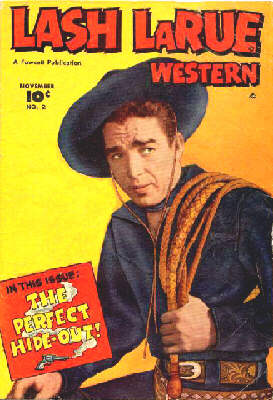Lash La Rue
Click here for Early Movie History category page |
Lash La Rue (June 14, 1917–May 21, 1996) was an actor noted for his roles in low-budget Westerns.
Early life and education
Born Alfred LaRue in Gretna, Louisiana, USA of Cajun ancestry, he was raised in various towns throughout Louisiana but in his teens the family moved to Los Angeles, California where he attended St. John's Military Academy.
Films
He began acting in films in 1944 as Al La Rue, appearing in two musicals and a serial before being given a role in a Western film that would result in him being cast in a cowboy persona for virtually the rest of his career. He was given the name Lash because of the 18-foot-long bullwhip he used to help bring down the bad guys. The popularity of his first role as the Cheyenne Kid, a sidekick of singing cowboy hero Eddie Dean, not just brandishing a whip but using it expertly to disarm villains, paved the way for La Rue to be featured in his own series of Western films. After appearing in all three of the Eddie Dean Cinecolor singing Westerns in 1945/46, he starred in quirky B-westerns from 1947 to 1951, at first for Poverty Row studio PRC, and later for producer Ron Ormond. La Rue developed his image as a cowboy hero dressed all in black and inherited from Buster Crabbe a comic sidekick in the form of "Fuzzy Q. Jones" played by the great Al St. John.
La Rue was different from the usual cowboy hero of the era; dressed in black, he spoke with a "city tough-guy" accent, somewhat like that of Humphrey Bogart, whom he resembled. His use of a bullwhip, however, was what set him apart from bigger cowboy stars such as Gene Autry and Roy Rogers. His influence was felt throughout the dying medium of B-westerns; for example, he had an imitator, Whip Wilson, who starred in his own brief series, and even Roy Rogers started picking up and using a bullwhip in some of his Republic Studios westerns made in the same period.
La Rue also made frequent personal appearances at small-town movie theaters that were showing his films during his heyday of 1948-1951, becoming the only cowboy star most children of the time ever got to see and meet in person. His skillful displays of stunts with his whip, done live on movie theater stages, also convinced young western fans that there was at least one cowboy hero who could do in real life the same things he did on screen.
Lash La Rue Western comic books were published first by Fawcett Comics and later by Charlton Comics, between 1949 and 1961. They were among the most popular western-themed comics of the era, running for more than 100 (usually monthly) issues.
In the later 1950s, he appeared in featured roles in a number of episodes of the television series 26 Men and Judge Roy Bean as well as having a continuing role as Sheriff Johnny Behan on The Life and Legend of Wyatt Earp. However, after decades of popularity, interest in westerns faded and La Rue was forced to make a living from appearances at conventions for western film buffs and sometimes as an evangelist on the rodeo and country-music circuit. Problems with the Internal Revenue Service made it difficult for LaRue to work. A role as the villain in a pornographic western, Hard on the Trail, led him to repentance as a missionary for ten years, as he had not been informed of the adult nature of the film and would not have consented had he known (he did not appear in any pornographic scenes). The film was released without the pornographic scenes and retitled Hard Trail to eliminate the double entendre. Late in his career, he appeared in two low-budget horror films shot in the South, Alien Outlaw and The Dark Power. In the latter, he plays a park ranger who makes extensive use of the bullwhip to battle wild dogs and attacking zombies.
La Rue was also noted for instructing Harrison Ford in how to use the bullwhip for the Indiana Jones movies.
La Rue often returned to his native Louisiana, where he was a regular at the jam sessions at the Dew Drop Inn in New Orleans. In his autobiography, Backbeat, drummer Earl Palmer recalls:
"Lots of white people wanted to come to the Dew Drop. Most were turned away, but they let a few in. Every time the cowboy actor Lash La Rue came in town, he came by. He played a hell of a guitar and was a regular guy that people liked."
La Rue died in Burbank, California and is believed to be interred in the Forest Lawn Memorial Park in Glendale, California
Trivia
- Professional wrestler John LeRoux borrowed his ring name from La Rue, dubbing himself "Lash LeRoux" in 1999.
- In the film Pulp Fiction, Winston Wolf refers to Vincent Vega as Lash LaRue and asks if he can keep his spurs from jingling and jangling.
- He was mentioned in The Statler Brothers song "Whatever Happened to Randolph Scott?"
- He is mentioned in the Tom Paxton song "My Pony Knows the Way."
- In the Rockford Files episode 'A Material Difference', Jim asks if Angel is moonlighting as Lash LaRue.
- He was one of several people injured by a tornado while in attendance at the Missouri State Fair in Sedalia, MO on August 20, 1952.
References:
- Lash LaRue, the King of the Bullwhip, by Chuck Thornton and David Rothel (Empire Publishing, NC, 1988). ISBN 0-944019-06-4.
- The King of the Bullwhip: Lash La Rue, the Man, not the Legend, by Charles M. Sharpe (Sharpeco, NC, 1996). asin B0006QS5T6.
Quotes
- (Winning a fight handily, pauses) "You sure you don't want to try something else?"
References
External links
Chat rooms • What links here • Copyright info • Contact information • Category:Root
